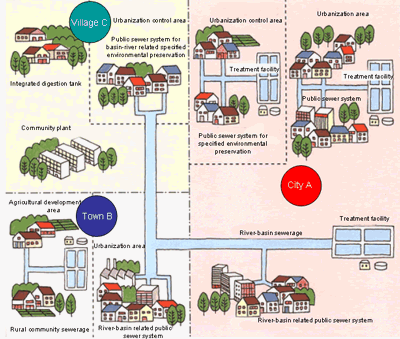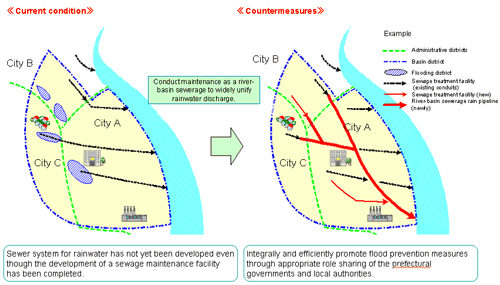- bJapanese topb


The public sewer system is a sewer system that is gcontrolled by the local public authorities in order to exclude or process sewage water mainly in the urban districts. They come with a disposal treatment facility or those that are connected to the river-basin sewerage that has a structure of a closed conduit for the most part of the sewerage facility in which sewage water must be excludedh (Article 2, clause 3 of the Sewerage Service Act). In principle, the local authorities implement the establishment/control of the public sewer system. However, in case at least two local authorities receive benefit from this and it is demonstrated that it is difficult to establish the facilities only through local authorities, the prefectural governments can execute establishment/control. In addition to this, from the year 1991, as an exception and based on the special measures law of local revitalization for depopulated districts, for those that satisfy a certain fixed requirement among the depopulated areas, it became possible for the prefectural governments to act for the local authorities to establish fundamental areas of the main pipe, drainage, etc.
Among public sewer systems, those facilities that are mainly used for business activity of a specific business are called the gspecific public sewer system.h Specifically, within the planned sewage water amount of the relevant sewer system, it is caused by the business activity of the business or is thought to dominate roughly over 2/3 of planned sewage water. (For the implementation of the law which partially revises the Sewerage Service Act (issue 35 November 10, 1971)
In addition, all of the sewer systems mentioned below are referred to as the gspecified environmental preservation public sewer system.h
Among public sewer systems, sewer systems that are set outside the urbanization areas (regarding urban planning districts that have not yet been set with an urbanization area, the already existing urban areas and the areas that surround them are referenced. This refers to districts with a concentration of population commonly referred to as the white urban planning districts.). Also included are those sewer systems that are specified in Article 2 of the National Park Acts to preserve the water quality of the water districts within the districts of the National Park (hereinafter referred to as a nature preservation sewer system). Also included are those to be implemented within the districts that have the necessity to execute improvement of the living environment by the maintenance of the public sewer system (hereinafter referred to as the farming and fishing villages) or districts where water quality preservation is essential with a population of under 1,000 people (hereinafter referred to as simple public sewer system).
Furthermore, a sewer system other than these specified public sewer systems and specified environmental preservation public sewer systems are designated as a restricted gpublic sewer system.h
Specified public sewer systems had been executed as a special urban sewer system business before 1971. However, with the revision of the Sewerage Service Act in 1970, it was required that all public sewer systems have a disposal treatment facility or connection to river-basin sewerage. Accordingly, the treatment facility established in the special urban sewer system was included in the idea of the disposal treatment facility and since then it was implemented as a specified public sewer system.
River-basin sewerage is ga sewer system that holds a disposal treatment facility which also excludes sewage water from at least two local districts which are controlled by the local authorities to process or exclude the sewage water from the sewer system that is independently controlled by the local authoritiesh (Sewerage Service Act Article 2, clause 4 a). In addition to this, it is referred to as the gsewer system controlled by the local authorities that discharges only rainwater excluded from the public sewer system (limited to those with disposal treatment facilities) to the rivers or other public water districts or to the ocean areas that hold a facility to adjust the amount of rainwater flow and that excludes rainwater in at least two local districtsh (Sewerage Service Act Article 2, clause 4 b). Generally, the control and establishment of river-basin sewerage is conducted by the prefectural governments but the local authorities can also execute operations in cooperation with the prefectural governments.
The river-basin sewerage specified in Sewerage Service Act Article 2, clause 4 a was established due to the expansion of the urban districts with changes in the municipality and in the social situation such as the increase of awareness toward the necessity of water preservation. With these changes, the necessity of implementation and planning from a wide perspective that crosses over the political districts based on units of basin, such as rivers, without limiting the execution on a local level has grown for the existing sewer system operation.
The first implementation of the river-basin sewerage in Japan took place at the Neyagawa basin in Osaka (1965). However, since those times, as there were no clear regulations for the Sewerage Service Act, the river-basin sewerage was thought of as being a part of public sewer system. The law system on river-basin sewerage was established in 1970 on the occasion of the revision of the Sewerage Service Act.
On the other hand, the reason why maintenance was conducted for river-basin sewerage (rainwater river-basin sewerage) specified in the Sewerage Service Act Article 2, clause 4 b was due to the development of urban areas and the necessity for the prefectural governments to efficiently implement flood prevention for several local districts due to the frequent occurrence of the concentrated heavy rain. With this, it has become possible to conduct maintenance as river-basin sewerage that excludes only rainwater in at least two local districts starting in 2005. (However, this is limited to rainwater excluded from the public sewer system that holds a disposal treatment facility.)
Furthermore, in case the river-basin sewerage that used to exclude sewerage in at least two districts will exclude sewerage from single local districts due to the merging of cities, a special law for the merging of cities that considers the existing sewer system as the river-basin sewerage in a span that does not exceed 10 years has been established under consultations between the prefectural governments and the new local authority created by the merging of cities.
A city sewer system only serves for the purpose of excluding rainwater independently in cities (outside the draining districts of public sewer system) and is a system that does not hold a disposal treatment facility.